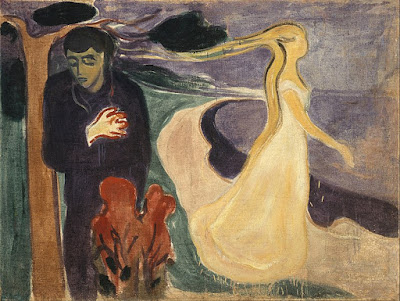Historical analysis in environmental law II: "The one came not near the other all the night"
 |
| Edvard Munch, Separation (1896) |
In May 2010 Environmental History, the leading journal in its field, published an article by Aaron Sachs on antebellum environmental thought as expressed in contemporary American cemeteries. A few months later legal historian Alfred Brophy published a blog post on American antebellum constitutionalism as expressed in speeches made in cemeteries. Though both pieces focused on the same cemeteries, with rich discussions of the political, social, and cultural contexts in which they operated, neither work made any reference to the other, nor, indeed, to the literature or historical sub-discipline in which the other was located. Three years later, both pieces were released in expanded form, again with no interaction between them or their scholarly worlds.
This was not an isolated (non-)incident. Though the fields of environmental history and legal history seemingly share a wealth of common interests—the histories of capitalism, slavery, and the administrative state are a few of the topics receiving intense attention in both fields in recent years—the two fields move through parallel intellectual universes with nary a glance at one another.
If there is a certain symmetry in the blissful ignorance in which each field operates with regard to the scholarship of its sister field, the same cannot be said of the relative interest each takes in the subject matter of the other. In the last decade (2007-2016) Law and History Review, the leading English-language legal history journal, published only three articles that might be described as engaging with environmental issues; and only one of these—its author an environmental historian, not a legal one—was directly on an environmental topic. Meanwhile the situation in Environmental History, the leading journal in its field, in the same period was radically different; counting conservatively, over twenty-five articles in this journal engaged significantly with legal issues, on a wide variety of topics, including a collection of essays dedicated to a single environmental statute. A similar picture emerges from an examination of leading European journals in the two fields: On the one hand, Journal of Legal History with two articles dealing with issues of public property that might be tagged as environmental and Rechtsgechichte with three on environmental topics; on the other, Environment and History with close to thirty articles with significant treatment of legal issues.
Read more »



Comments
Post a Comment